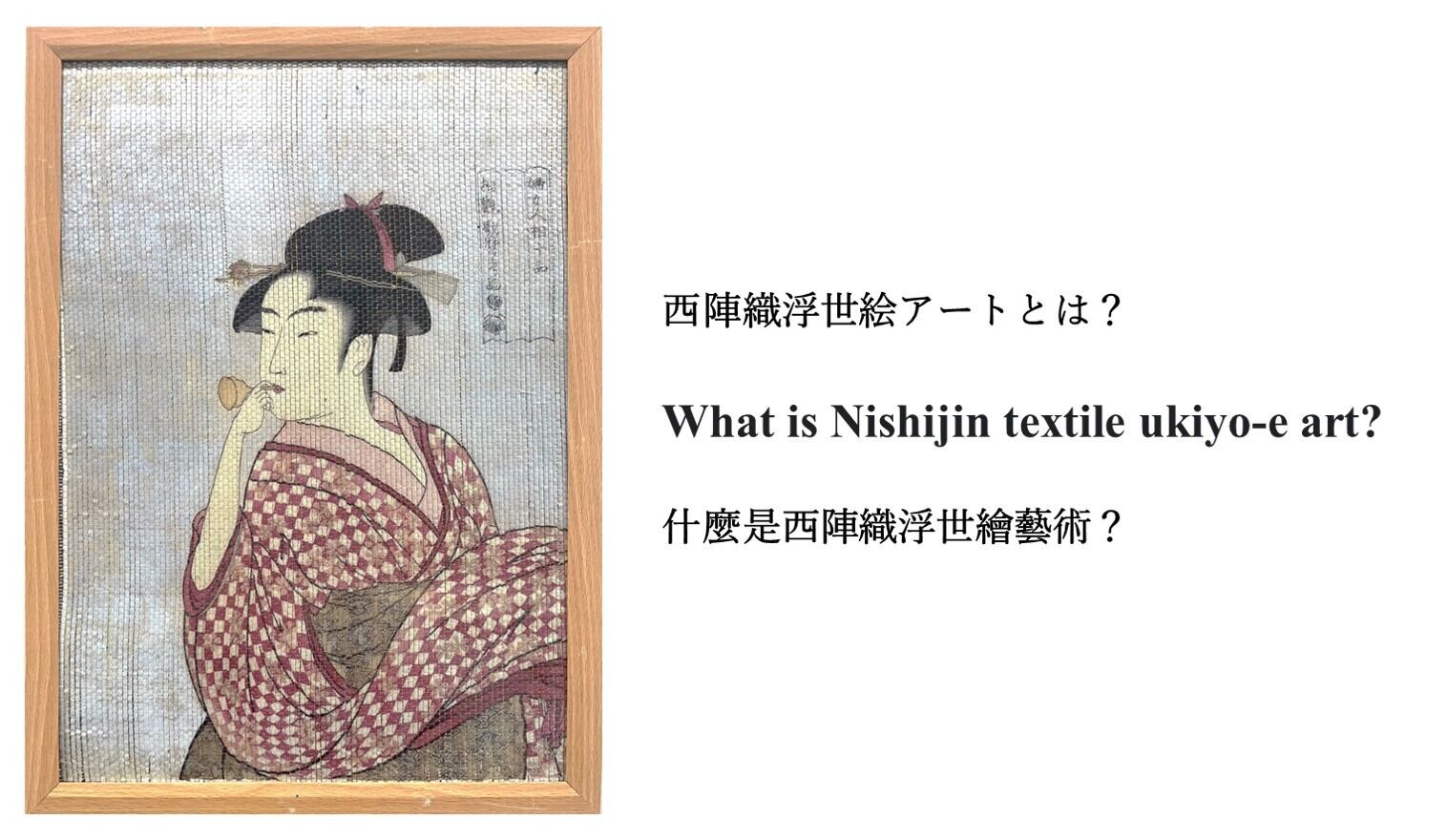これが作品の一例です。
一見、普通の絵画に見えるかもしれませんがそうではありません。
京都の伝統技能である西陣織の「引箔」という技術で織られた浮世絵のアートです。「引箔」とは金箔や銀箔を漆で貼り付けた和紙を糸状に細かく切断して西陣織の帯や装束に織り込む技術である。
まず浮世絵をカラー印刷し、それを2㎜幅に裁断する。
この2㎜に裁断された紙は経糸として使われる。
緯糸には絹糸や木綿糸、金糸、銀糸を重ねて織り込みます。
つまり、経糸に紙、緯糸に糸を使い、西陣織の技術で織ったものが、この「織物の浮世絵アート」になっています。
This is an example of the work.
At first glance, it may look like an ordinary painting, but it is not.
This is an ukiyo-e art woven using Nishijin-ori‘s “Hikihaku” technique, a traditional technique from Kyoto. “Hikihaku” is a technique in which Japanese paper with gold or silver foil pasted with lacquer is cut into fine threads and woven into the obi of Nishijin-ori.
First, print the ukiyo-e in color and cut it into 2mm width pieces.
This 2mm paper is used as warp threads.
Silk, cotton, gold, and silver threads are layered and woven into the weft.
In other words, this “Ukiyo-e textile art” is woven using Nishijin-ori techniques, using paper for the warp and thread for the weft.
這是作品的一個例子。
乍一看,它可能看起來像一幅普通的畫,但事實並非如此。
這是採用京都傳統技藝西陣織「引箔」技藝編織而成的浮世繪藝術品。「引箔」是將貼有漆的金箔或銀箔的和紙切成細線,編織成西陣織腰帶的技術。
首先,將浮世繪彩色印出來,然後切成2毫米寬的小塊。
這張2毫米的紙作為經線。
絲、棉、金、銀線分層織入緯線。
換句話說,這種「浮世繪紡織藝術」是採用西陣織技術,以紙為經線,以線為緯線編織而成的。
上の写真が原画で、下が作品です。
葛飾北斎の富嶽三十六景の1図、「神奈川沖浪裏」
日本絵画の中でも、最も世界的に知られた一枚で「グレート・ウェーブ」と称される。
長年培った手織りの技術が、浮世絵独特の色合いや大胆な構図、細やかな表現に生かされている。
江戸時代の浮世絵師・葛飾北斎の代表作「富嶽三十六景」を再現した作品46点を2部ずつ3年がかりで作り上げた。
右は富士山を正面から大きく描いた「凱風快晴」という作品です。
別名「赤富士」と呼ばれる名作です。
The picture above is the original picture, and the picture below is the work.
One of Katsushika Hokusai's Thirty-six Views of Mt. Fuji, "The Great Wave off Kanagawa“
It is one of the most internationally known Japanese paintings and is known as the “Great Wave.”
The hand-woven techniques cultivated over many years are utilized in the unique colors, bold compositions, and detailed expressions of ukiyo-e.
It took three years to create two copies of 46 works that recreate “Thirty-six Views of Mt. Fuji,” a masterpiece by Edo period ukiyo-e artist Katsushika Hokusai.
On the right is a work called “Fine Wind,Clear Morning(Gaifu Kaisei)” that depicts Mt. Fuji from the front.
This is a masterpiece also known as "Red Fuji."
上圖為原圖,下圖為作品。
葛飾北齋富士山三十六景之一的《神奈川衝浪裡》
它是國際上最知名的日本繪畫之一,被稱為“巨浪”。
浮世繪獨特的色彩、大膽的構圖和細緻的表現,運用了長年累積的手工編織技術。
再現了江戶時代浮世繪家葛飾北齋的傑作《富士山三十六景》,歷時3年創作了兩幅46幅作品。
右邊是從正面描繪富士山的作品《凱風快晴》
這是又被稱為「紅富士」的傑作。
「大地震で被災した人たちが自分の作品を見て和んでくれたら」
2023年2月のトルコ・シリア地震が発生した時、葛飾北斎の「富嶽三十六景」46点を制作し、トルコ大使館に寄贈しました。
2023年6月には戦争で多くの命が奪われたウクライナ人のために、歌川広重の「冨士三十六景」を、2024年2月にはポルトガル大使館へ「東海道五十三次」を寄贈しました。
これからも作品を通じて世界や社会に貢献をしていきたい。
“I hope people who suffered from the earthquake will see my work and feel at ease.‘’
When the Turkey-Syria earthquake occurred in February 2023, we created 46 works of Katsushika Hokusai‘s “Thirty-Six Views of Mt. Fuji'' and donated them to the Turkish Embassy.
In June 2023, Hiroshige Utagawa‘s “Thirty-six Views of Fuji’‘ will be presented to the Ukrainian people who lost many lives in the war, and in February 2024, ”The 53 Stations of the Tokaido'' will be presented to the Portuguese Embassy. donated.
I would like to continue contributing to the world and society through my works.
“我希望那些遭受地震襲擊的人們看到我的作品並感到安心。”
2023年2月土耳其和敘利亞發生地震時,我們創作了葛飾北齋的《富士山三十六景》46幅作品,並捐贈給土耳其大使館。
2023年6月,歌川廣重的《富士三十六景》將贈送給在戰爭中喪生的烏克蘭人民,2024年2月,《東海道53站》將贈送給在戰爭中喪生的烏克蘭人民。葡萄牙大使館捐贈。
我想繼續透過我的作品為世界和社會做出貢獻。



